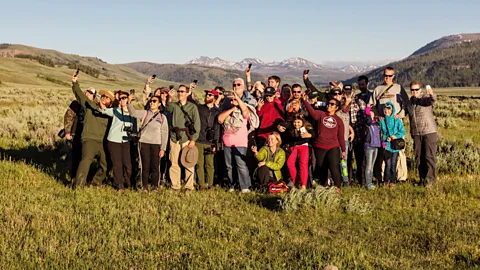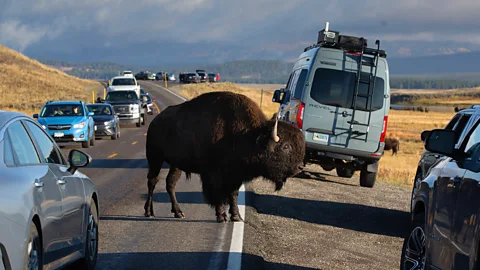Three things not to do when travelling to US National Parks
 Alamy
AlamyPierce Brosnan's alleged “bad tourist” moment is a reminder to be a safe traveller in US National Parks. In addition to unique park rules, keep these three things in mind.
This week, Pierce Brosnan pled not guilty to charges that he illegally entered the acidic hot springs area of Yellowstone National Park. If found guilty, the actor will have fallen from Bond hero to "bad tourist" in a moment that occurred when he allegedly wandered off-trail and was subsequently cited by a US attorney for Wyoming. But he's not the only one accused of breaking the rules in US national parks.
A 2022 Wyoming Law Review article tells the tale of how steady increases in what the NPS calls "national resource violatons" – this can mean any number of misbehaviors on protected park land, from Brosnan's alleged trespassing into restricted thermal areas to other serious crimes such as vandalism or poaching – led to the creation of the Yellowstone Justice Center in 2008. The centre is where law enforcement and judicial proceedings take place for infractions committed in the park.
In June 2023, the park shared a press release about how visitor actions led to the death of two black bears and a bison calf. There's even a Tourons of Yellowstone ("tourist" plus "moron") Instagram handle with nearly 1,300 posts about tourists behaving badly.
Thankfully, NPS visitor guidelines provide clarity as to how to stay on the right side of the law. Cynthia Hernandez, National Park Service (NPS) spokesperson, encourages visitors to join the Plan Like a Park Ranger effort that helps tourists travel more responsibly in parks. "Every visitor plays an important role in stewardship of the more than 400 national parks across the country." Of travellers like Brosnan, Hernandez adds that "visitors who violate park rules and regulations are subject to fines and/or imprisonment."
 Getty Images
Getty ImagesWhat National Parks travellers should know
In 2022, NPS hosted 312 million recreational visitors across the National Park system, which includes well-known parks and national monuments that preserve archaeological heritage. Each park has a location-specific website that outlines its unique park rules, and you can download the NPS app to find interactive maps about points of interest at your destination. Most of the regulations are common sense, but some are easy to forget.
For example, Joseph Boschulte, commissioner of the US Virgin Islands (USVI) Department of Tourism, says overnight camping and exploring non-designated routes in unique underwater snorkeling and diving trails, such as as Trunk Bay is generally prohibited.
Similarly, "visitors should be aware that flying drones is strictly prohibited within any national park in the USVI," he adds. This one might trip up travel bloggers and photo enthusiasts alike, but it's in place for good reason. These guidelines protect the fragile environment, wildlife and the safety of park-goers.
Although each park has its own specific rules about safe areas to explore and camp, there are three no-nos that apply at all national parks.
 Getty Images
Getty ImagesDon't pet the animals
A national park is not a petting zoo. The animals are wild, and they're not socialised for regular contact with people. Not only can they hurt you – you can hurt them. In 2026, a well-intentioned visitor put a baby bison in their car and drove it to a ranger station because of what the NPS called "their misplaced concern for the animal's welfare". When the rangers tried to return it to the herd, it was rejected and eventually had to be euthanised.
Instead of approaching and/or touching any wildlife, call a ranger to the scene. Park regulations are to stay at least 25 yards (23m) away from all wildlife and at least 100 yards (91m) away from wolves and bears.
Don't go leash-less
In some parks, household pets are welcome. However, they aren't meant to roam free. In 2021, a 20-year-old woman suffered thermal burns while trying to rescue her runaway dog from a hot spring. Although the circumstances were different, hers is a cautionary tale for boundary breakers like Brosnan, who was lucky he wasn't severely injured by the high-temperature mud pools, vents and geysers in thermal areas.
Four-legged friends who will be frequent visitors are welcome to become B.A.R.K. Ambassadors. They might even cosy up to some of the working dogs and dog handlers in the B.A.R.K. Rangers program. But there are pet policies in place to protect your pet, as well as wildlife and other visitors.
Leave No Trace
Practising the National Park Service's 7 Leave No Trace principles should be straightforward. Unless you live within the parkland's borders, no one should even know you've been there.
For the rest of us, the rules are simple: Travel and camp on maintained trails and designated campsites, repackage food to minimise waste and use established fire rings, fire pans or mound fires in approved areas. Boschulte adds that you should "pack out all trash, avoid picking plants or disturbing rocks and keep noise levels to a minimum."
Finally, the Office of the Superintendent at Yellowstone National Park encourages visitors to go a step further and take the #YellowstonePledge that you’ll follow ten top tips – such as giving wildlife a wide berth and leaving drones at home – in order to further protect the park.
---
If you liked this story, sign up for the weekly bbc.com features newsletter called "The Essential List". A handpicked selection of stories from BBC Future, Culture, Worklife and Travel, delivered to your inbox every Friday.
